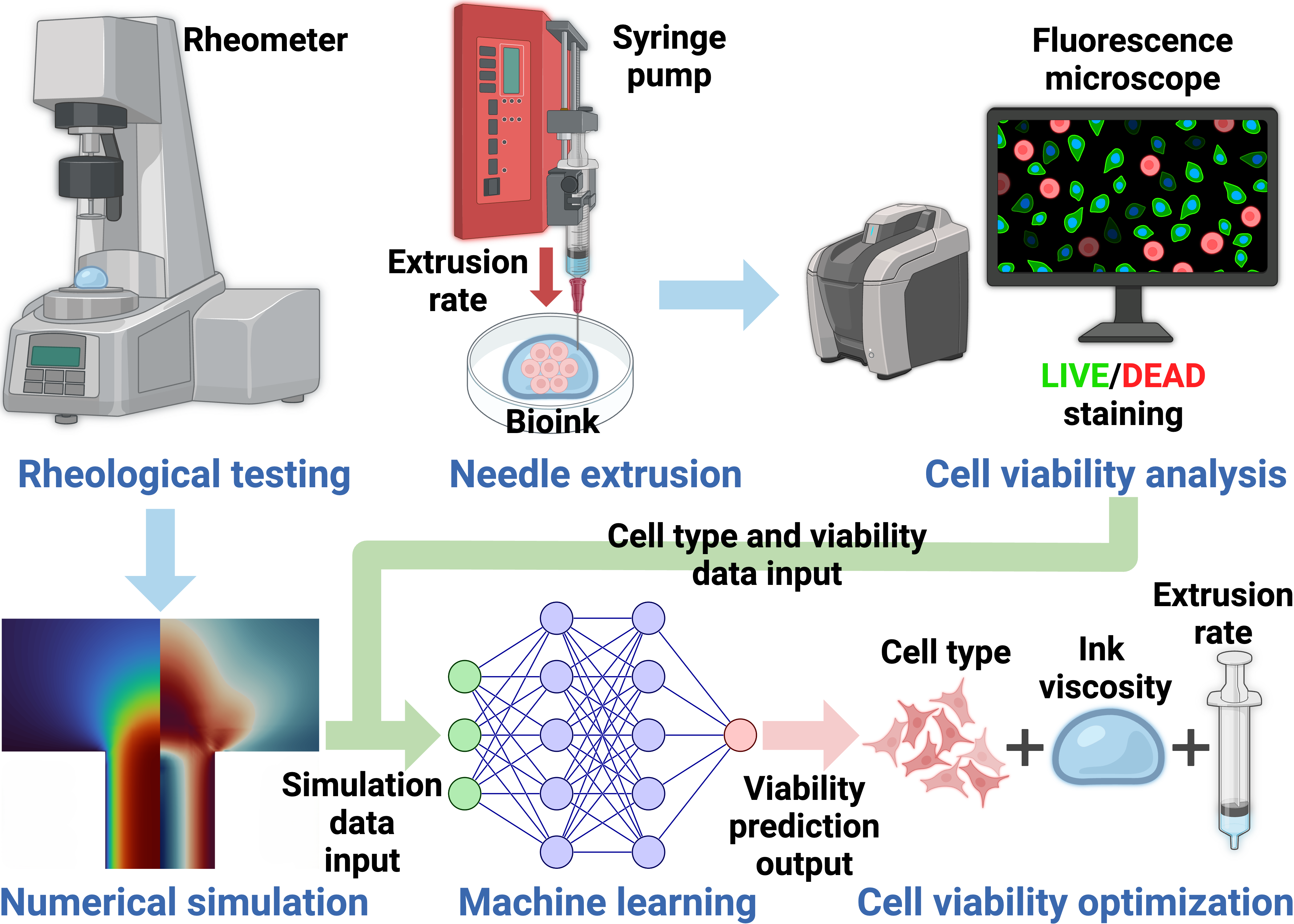>>> Hello, World!
I'm Colin Zhang, currently a Ph.D. student at The University of Osaka. My research topics involve additive manufacturing, numerical simulation, and machine learning. I graduated from UC Santa Barbara with a B.S. in Mechanical Engineering in 2020. I continued my studies at The University of Osaka and completed my M.E. in Chemical Engineering in 2023.
Throughout my academic journey, I developed expertise in Python and machine learning. My current research leverages machine learning to optimize 3D bioprinting processes. This work involves predicting cell viability affected by the extrusion process in 3D bioprinting through numerical simulations, support vector regression (SVR), and multilayer perceptron (MLP) models. Another focus area is to develop a novel printing performance evaluation framework that combines the Hausdorff distance (HD) with convolutional neural networks (CNNs) to assess geometric fidelity automatically. Additionally, generative AI models such as conditional variational autoencoders (CVAEs) were explored to generate printing outcome predictions based on ink rheological properties and printing parameters.
When I'm not in the lab, you'll often find me planning my next mountain climbing adventure or exploring new places in Japan. I'm constantly curious about learning new things, whether through watching online courses or getting lost in a good book on a quiet evening. These pursuits keep me balanced and bring fresh perspectives to both my research and everyday life.
Research Interests
3D bioprinting is advancing rapidly in the field of tissue engineering, enabling the creation of complex, biologically engineered structures with high precision. Key challenges in the process include optimizing needle geometry, extrusion parameters, and maintaining cell viability. Numerical analysis and machine learning are increasingly applied to control factors such as fluid shear stress, ink rheology, and extrusion velocity, improving printability and ensuring better cell survival rates in the printed structures. This combination of computational methods and experimental validation offers a promising path toward more effective bioprinting solutions for tissue regeneration and therapeutic applications.
Publications
- Colin Zhang, Kelum Elvitigala, and Shinji Sakai.
AI-powered printability evaluation
framework for 3D bioprinting using Hausdorff distance metrics. Biofabrication 18,
015015
(2026).
https://doi.org/10.1088/1758-5090/ae288c. [Publisher Preview] - Colin Zhang, Kelum Elvitigala, Wildan Mubarok, Yasunori Okano, and Shinji Sakai.
Machine learning-based prediction and optimisation framework for as-extruded cell viability in
extrusion-based 3D bioprinting. Virtual and Physical Prototyping 19, e2400330
(2024).
https://doi.org/10.1080/17452759.2024.2400330. Open Access. - Mitsuyuki Hidaka, Masaru Kojima, Colin Zhang, Yasunori Okano, and Shinji Sakai.
Experimental and numerical approaches for optimizing conjunction area design to enhance
switching efficiency in single-nozzle multi-ink bioprinting systems. International Journal of
Bioprinting 10, 4091 (2024).
https://doi.org/10.36922/ijb.4091. Open Access. - Wildan Mubarok, Colin Zhang, and Shinji Sakai. 3D Bioprinting of Sugar Beet
Pectin
through Horseradish Peroxidase-Catalyzed Cross-Linking. ACS Applied Bio Materials
7, 3506-3514 (2024).
https://doi.org/10.1021/acsabm.4c00418.
Conferences
- The 90th Annual Meeting of The Society of Chemical Engineers, Japan, Tokyo University of
Science, March 11-14, 2025
Presentation Title: AI-Driven 3D Bioprinting System for Optimizing Printing Performance
Colin Zhang, Kelum Elvitigala, and Shinji Sakai -
The 55th Autumn Meeting of The Society of Chemical Engineers, Japan, Hokkaido University,
September 10-13, 2024
Presentation Title: Predictive modeling of cell viability in extrusion-based 3D bioprinting using machine learning [Featured Presentation (22 out of 1130)]
Colin Zhang, Yasunori Okano, and Shinji Sakai -
The 53rd Autumn Meeting of The Society of Chemical Engineers, Japan, Shinshu University,
September 14-16, 2022
Presentation Title: A Numerical Investigation of Stresses, Printing Efficiency, Printability, and Cell Viability in Nozzle Printheads for 3D Extrusion Bioprinting
Colin Zhang, Mitsuyuki Hidaka, Masaru Kojima, Shinji Sakai, and Yasunori Okano
Course Certificates
- Computer Science for Artificial Intelligence
- CS50AI: Introduction to Artificial Intelligence with Python
- CS50x: Introduction to Computer Science
- Mathematics for Machine Learning: Linear Algebra
- The Git & Github Bootcamp
Contact Information
You can reach me by executing the following Python script, which uses ASCII-to-string conversion:
"".join(chr(i) for i in (107, 111, 114, 105, 110, 46, 106, 97, 112, 97, 110, 64, 103, 109, 97, 105, 108, 46, 99, 111, 109))Or, the JavaScript version which can be run directly in your browser's console:
String.fromCharCode(107, 111, 114, 105, 110, 46, 106, 97, 112, 97, 110, 64, 103, 109, 97, 105, 108, 46, 99, 111, 109);
